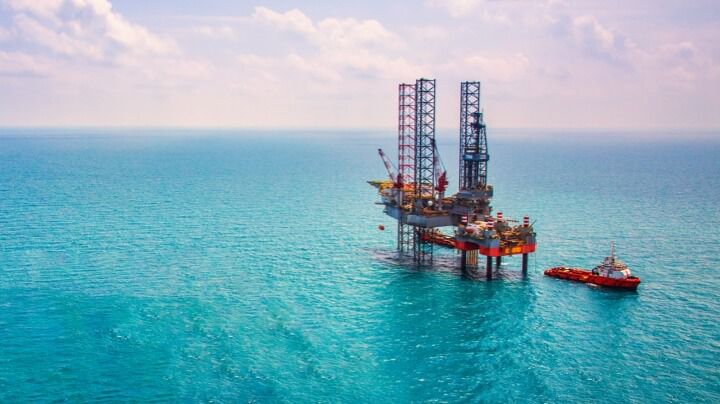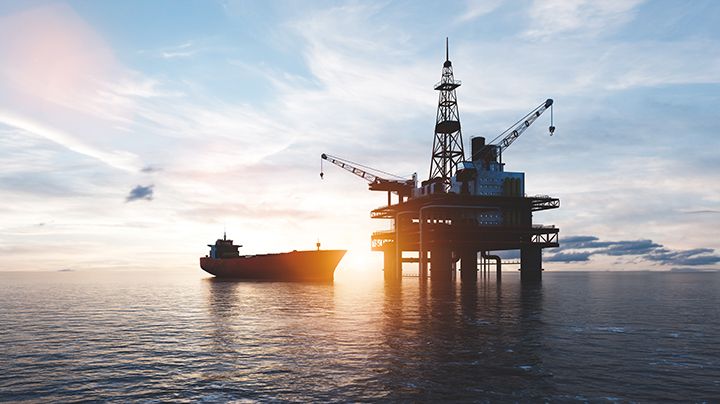Onshore and offshore solutions for enhanced oil recovery (EOR) and produced water treatment
Enhanced oil recovery (EOR), also called tertiary recovery, is a technique used to increase the recovery of crude oil extracted from an oil formation. It involves injecting a substance into a formation to increase the amount of oil recovered. This can increase the recovery rate by 30-60%, compared to the 5-15% typically recovered in the primary stage. Produced water is the water byproduct that comes out of the well with the crude oil during this EOR process.
The composition of produced water varies widely from well to well. It typically contains soluble and non-soluble oil/organics, suspended solids, dissolved solids, and toxic heavy metals. It must be treated before it can be discharged or injected back into the ground. As regulations have become increasingly stringent, disposal costs rise and freshwater supply becomes scarcer. Because of this, produced water treatment for reuse is becoming a more viable option.
Preserving and restoring the world’s water supply remains as one of the world’s top environmental challenges. Minimizing waste is one of the principles behind any circular economy initiative. Failing to purify produced water before discharging it back into the environment has dire consequences. More stringent legislation across the globe and increased awareness of corporate social responsibility towards sustainability are leading corporations to enforce and implement new solutions to tackle some of the issues that result from uncontrolled disposal of pollutants.
Effective upstream oil and gas technologies for the removal of critical contaminants in produced water can help avoid:
- Hindering of downstream unit operations
- Fines/penalties for exceeding discharge permits
- Polluting the environment
In the end, it can be costly to ignore the importance of effectively removing certain contaminants. Finding cost-effective solutions is as important as ever. DuPont Water Solutions helps the oil & gas industry solve challenging environmental issues with best-in-class industrial water treatment solutions.
Produced water treatment technologies for contaminant removal
Effectively removing organics and/or oil from produced water streams
Oil & Gas wastewater treatment capabilities require a focus on organic compound removal. The organic load composition is expressed as BOD, COD, TOC, or oil concentration and is often a limit for wastewater discharge permits. In the case of environmental remediation of contaminated solids, the removal of the organic/solvent/fuel is a must to meet overall standards.
The most common type of organic contamination in water in the oil & gas industry are oil, paraffins, and hydrocarbons. Oil is mostly found in the water from distillates in refineries, chemical processes, or the water associated with hydraulic fracturing and drilling, also commonly known as produced water. This presents an opportunity to recover valuable hydrocarbons and treat the water for suitable recycling or disposal. Oil-in-water may appear in several different forms: free oil, emulsified oil, and dissolved oil. DuPont Water Solutions offers solutions for both emulsified oil and dissolved oil removal.
Emulsified oil removal with oil-coalescing media
Emulsified oil can be removed by coalescing and decanting, using ion exchange resin bed containing oil-coalescing media. This media has oleophilic properties that attract oil molecules very efficiently. The media resizes the small oil droplets from microns to millimeters in size, allowing them to be easily separated.
Dissolved oil, volatile organic carbon (VOC), and hydrocarbon removal with polymeric adsorbents
Polymeric adsorbents can remove organic compounds from water, including light hydrocarbons, volatile organics, aromatic and phenolic compounds. Most of the compounds found in dissolved oil can be removed by adsorption. DuPont’s polymeric adsorbents can effectively remove a wide variety of these organic compounds.
Biodegradable organics and nutrients removal with MBR
A membrane bioreactor (MBR) uses the combination of suspended growth biological treatment usually activated sludge, with membrane filtration equipment. Proven to deliver greater effluent productivity while reducing the lifecycle cost, MemPulse™ MBR technology uses a fully automated process that provides liquid/solid separation by combining biological waste oxidation and membrane separation. In turn, this eliminates the need for secondary clarification.
View all products for Organics & Oil Removal
View all products for Biodegradable Organics & Nutrients Removal
Addressing high salinity streams in produced water with nanofiltration and reverse osmosis
Oilfield produced water can often contain high levels of total dissolved solids (TDS) in addition to hydrocarbons, precipitates, and suspended particles. Dissolved solids mainly consist of sodium, calcium, and magnesium salts. The combination of the high salinity and hardness in produced water can be very detrimental.
Minimal liquid discharge (MLD) solutions can help address produced water regulatory challenges, particularly around salinity. High-recovery RO systems can increase water recovery while reducing energy use, which minimizes operating costs. DuPont offers RO elements for produced water treatment that are designed for different conditions, including low-energy/high-productivity, high-rejection, and high-fouling.
View all products for Salinity Management
Effective hardness removal with ion exchange and nanofiltration
In many cases, the removal of scale-forming divalent ions such as hardness and silica is more important than NaCl removal. DuPont™ AmberLite™ ion exchange resins can remove scale-forming cations such as Ca2+, Ba2+ and Sr2-, with a removal efficiency greater than 99.5%, reducing the risk of carbonate or sulfate scaling. DuPont™ AmberLite™ IRC83 H is widely used in the treatment of unconventional oil & gas wastewater streams because of its high capacity and stability.
Nanofiltration (NF) membranes are a good option for water softening if the feedwater characteristics and pretreatment are correct. They provide a high-water flux and lower rejection of monovalent ions than reverse osmosis membranes.
View all products for Hardness Removal
Technologies for heavy metal removal
Produced waters are often enriched with heavy metals including iron, copper, manganese, cadmium, lead, nickel, chromium, and mercury. Heavy metals can be removed from water at neutral pH with the use of a weak acid cation (WAC) exchange resin. Two options include DuPont™ AmberLite™ IRC83 H and AmberLite™ HPR1100 Na.
In acidic conditions, heavy metals can form anion complexes that can be removed with strong base anion (SBA) resins such as DuPont™ AmberSep™ 21K XLT or AmberLite™ HPR9200 Cl.
Most of these metals can also be selectively removed from solution with chelating resins such as DuPont™ AmberSep™ IRC748, AmberSep™ GT74 or AmberSep™ 43600.
Mercury can also form colloidal complexes that can be reliably removed with DuPont ultrafiltration SFP modules.
View all products for Heavy Metal Removal
-
Organics & Oil Removal
Effectively removing organics and/or oil from produced water streams
Oil & Gas wastewater treatment capabilities require a focus on organic compound removal. The organic load composition is expressed as BOD, COD, TOC, or oil concentration and is often a limit for wastewater discharge permits. In the case of environmental remediation of contaminated solids, the removal of the organic/solvent/fuel is a must to meet overall standards.
The most common type of organic contamination in water in the oil & gas industry are oil, paraffins, and hydrocarbons. Oil is mostly found in the water from distillates in refineries, chemical processes, or the water associated with hydraulic fracturing and drilling, also commonly known as produced water. This presents an opportunity to recover valuable hydrocarbons and treat the water for suitable recycling or disposal. Oil-in-water may appear in several different forms: free oil, emulsified oil, and dissolved oil. DuPont Water Solutions offers solutions for both emulsified oil and dissolved oil removal.
Emulsified oil removal with oil-coalescing media
Emulsified oil can be removed by coalescing and decanting, using ion exchange resin bed containing oil-coalescing media. This media has oleophilic properties that attract oil molecules very efficiently. The media resizes the small oil droplets from microns to millimeters in size, allowing them to be easily separated.
Dissolved oil, volatile organic carbon (VOC), and hydrocarbon removal with polymeric adsorbents
Polymeric adsorbents can remove organic compounds from water, including light hydrocarbons, volatile organics, aromatic and phenolic compounds. Most of the compounds found in dissolved oil can be removed by adsorption. DuPont’s polymeric adsorbents can effectively remove a wide variety of these organic compounds.
Biodegradable organics and nutrients removal with MBR
A membrane bioreactor (MBR) uses the combination of suspended growth biological treatment usually activated sludge, with membrane filtration equipment. Proven to deliver greater effluent productivity while reducing the lifecycle cost, MemPulse™ MBR technology uses a fully automated process that provides liquid/solid separation by combining biological waste oxidation and membrane separation. In turn, this eliminates the need for secondary clarification.
View all products for Organics & Oil RemovalView all products for Biodegradable Organics & Nutrients Removal
-
Salinity Management
Addressing high salinity streams in produced water with nanofiltration and reverse osmosis
Oilfield produced water can often contain high levels of total dissolved solids (TDS) in addition to hydrocarbons, precipitates, and suspended particles. Dissolved solids mainly consist of sodium, calcium, and magnesium salts. The combination of the high salinity and hardness in produced water can be very detrimental.
Minimal liquid discharge (MLD) solutions can help address produced water regulatory challenges, particularly around salinity. High-recovery RO systems can increase water recovery while reducing energy use, which minimizes operating costs. DuPont offers RO elements for produced water treatment that are designed for different conditions, including low-energy/high-productivity, high-rejection, and high-fouling.
View all products for Salinity Management
-
Hardness Removal
Effective hardness removal with ion exchange and nanofiltration
In many cases, the removal of scale-forming divalent ions such as hardness and silica is more important than NaCl removal. DuPont™ AmberLite™ ion exchange resins can remove scale-forming cations such as Ca2+, Ba2+ and Sr2-, with a removal efficiency greater than 99.5%, reducing the risk of carbonate or sulfate scaling. DuPont™ AmberLite™ IRC83 H is widely used in the treatment of unconventional oil & gas wastewater streams because of its high capacity and stability.
Nanofiltration (NF) membranes are a good option for water softening if the feedwater characteristics and pretreatment are correct. They provide a high-water flux and lower rejection of monovalent ions than reverse osmosis membranes.
View all products for Hardness Removal
-
Heavy Metals Removal
Technologies for heavy metal removal
Produced waters are often enriched with heavy metals including iron, copper, manganese, cadmium, lead, nickel, chromium, and mercury. Heavy metals can be removed from water at neutral pH with the use of a weak acid cation (WAC) exchange resin. Two options include DuPont™ AmberLite™ IRC83 H and AmberLite™ HPR1100 Na.
In acidic conditions, heavy metals can form anion complexes that can be removed with strong base anion (SBA) resins such as DuPont™ AmberSep™ 21K XLT or AmberLite™ HPR9200 Cl.
Most of these metals can also be selectively removed from solution with chelating resins such as DuPont™ AmberSep™ IRC748, AmberSep™ GT74 or AmberSep™ 43600.
Mercury can also form colloidal complexes that can be reliably removed with DuPont ultrafiltration SFP modules.
View all products for Heavy Metal Removal
Find products for produced water treatment
View a list of products suitable for contaminant removal from produced water streams.
Explore other oil & gas applications

We help energy companies improve operational efficiency with specialized water treatment and wastewater reuse.

Injection water quality is critical to improve oil recovery. We provide injection water treatment solutions that can be used for sulfate removal, offshore desalination, and more.

We provide efficient water treatment technologies for unconventional oil & gas extraction methods, such as hydraulic fracturing of shale oil, SAGD, and more.

